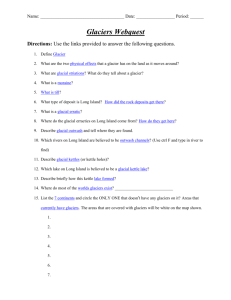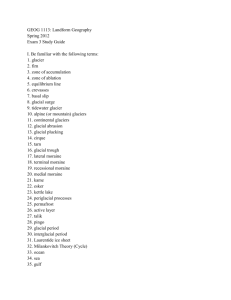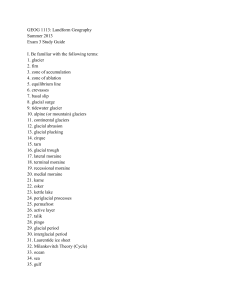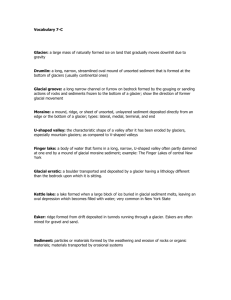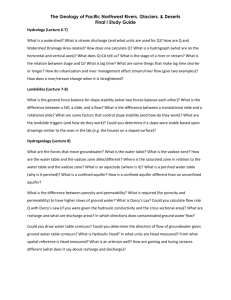Glacial Mass Balance Reconstruction Based on a Pinus albicaulis
advertisement
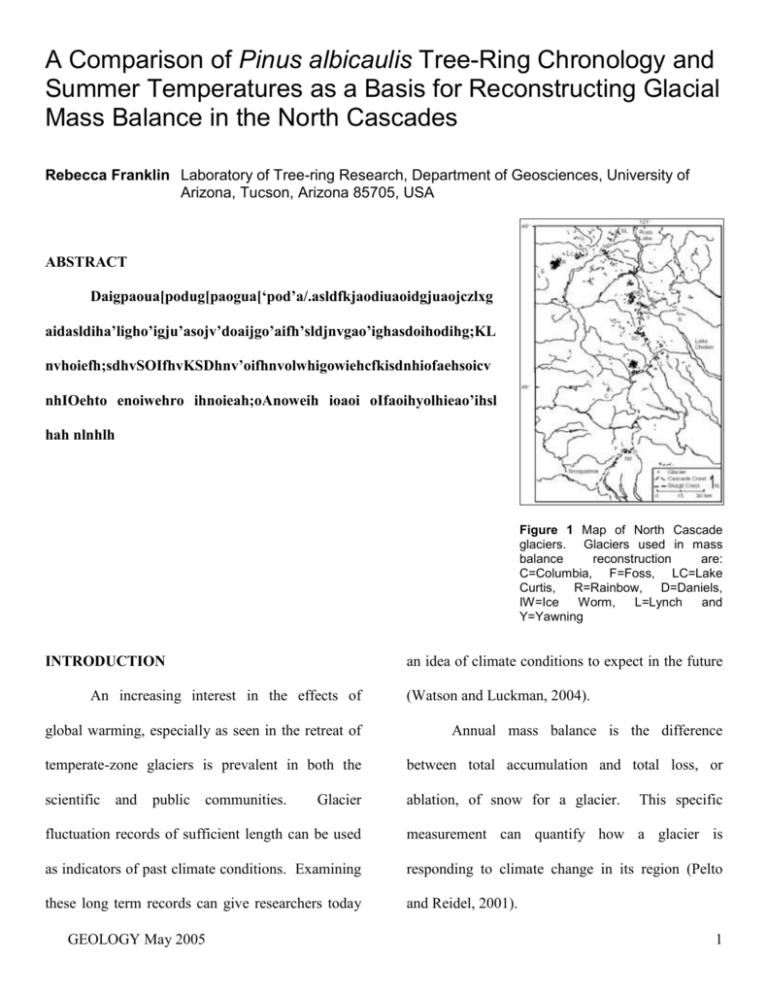
A Comparison of Pinus albicaulis Tree-Ring Chronology and Summer Temperatures as a Basis for Reconstructing Glacial Mass Balance in the North Cascades Rebecca Franklin Laboratory of Tree-ring Research, Department of Geosciences, University of Arizona, Tucson, Arizona 85705, USA ABSTRACT Daigpaoua[podug[paogua[‘pod’a/.asldfkjaodiuaoidgjuaojczlxg aidasldiha’ligho’igju’asojv’doaijgo’aifh’sldjnvgao’ighasdoihodihg;KL nvhoiefh;sdhvSOIfhvKSDhnv’oifhnvolwhigowiehcfkisdnhiofaehsoicv nhIOehto enoiwehro ihnoieah;oAnoweih ioaoi oIfaoihyolhieao’ihsl hah nlnhlh Figure 1 Map of North Cascade glaciers. Glaciers used in mass balance reconstruction are: C=Columbia, F=Foss, LC=Lake Curtis, R=Rainbow, D=Daniels, IW=Ice Worm, L=Lynch and Y=Yawning an idea of climate conditions to expect in the future INTRODUCTION An increasing interest in the effects of (Watson and Luckman, 2004). global warming, especially as seen in the retreat of Annual mass balance is the difference temperate-zone glaciers is prevalent in both the between total accumulation and total loss, or scientific ablation, of snow for a glacier. and public communities. Glacier This specific fluctuation records of sufficient length can be used measurement can quantify how a glacier is as indicators of past climate conditions. Examining responding to climate change in its region (Pelto these long term records can give researchers today and Reidel, 2001). GEOLOGY May 2005 1 Few mass balance records of sufficient However, in addition to trees in the length are currently available, with the lengthiest immediate vicinity being able to reproduce the records not usually exceeding the past few decades. climate signal affecting glacial mass balance, For extending glacial mass balance records into the attention needs to be paid to broad regional scale past, many proxies for mass balance have been climate signals, as glacial mass balance is highly used. Nicolussi and Patzelt, 1996 and Luckman, correlated 2000, have used lichonometric, dendrochronologic correlation values of up to 0.98 over a ~8000 km2 and historical records for reconstructing glacial area (Pelto and Reidel, 2001). across region scales, with cross- mass balances. Historical repeat photography is a The North Cascades Glacier Climate Project valuable resource but rare, and lichenometric has recorded mass balances of 8 different glaciers studies yield results that are not annual in (Fig.1) since 1984 (Pelto and Reidel, 2001). With resolution, as needed for annual mass balances this record, I will see how significant of a (Winchester and Harrison, 2000). reconstruction of past glacial mass balance I can get record with tree-ring by using both a local climate proxy (tree-ring chronologies are often used (Cook and Kairiukstis, records) and regional proxies (summer average 1990), as trees with strong climate signals are maximum temperatures and total snowfall). ubiquitous in regions of boreal-zone glacial activity. North Cascades are located in climate Region 5 of Using annual To obtain a resolution, dendrochronology to reconstruct Washington state. The Climate information for this glacial mass balance and other glacial processes region can be retrieved from the National Oceanic such as glacial advance and oscillations in length and has given fruitful results as in the cases of National Climatic Data Center using “NNDC LaMarche and Fritts in the Austrian Alps, 1971 and Climate Data Online”. Atmospheric Administration’s (NOAA) in the Patagonian Ice Field by Villalba et al, 1990. This region lies in an area that receives These and others have found that radial growth heavy precipitation, lying on the west side of the variations of high elevation trees are highly precipitation divide of Washington state. This and a correlated to local glacial activity. 2 GEOLOGY May 2005 moderate maritime climate and high mountain peaks (with glaciers at ~2500 meters) allow for the existence of both glaciers and forests in the same METHODOLOGY To reconstruct a history of glacial mass balance for a region ~8000 km2 in area, I used the location. What do I hope to find out with this mass balance record recorded by the North research? What seem to be the controls on glacial Cascades Glacier Climate Project (NCGCP). Their mass balance for the North Cascades region of record is of 8 glaciers located in the North Cascades Washington? Can glacial mass balance be between 120o and 122o W longitude and between reconstructed using a tree-ring chronology or would 49o and 48o N latitude. These are the Columbia, climatic factors be a more precise way to Foss, Lake Curtis, Rainbow, Daniels, Ice Worm, reconstruct mass balance? Of the climate variables Lynch and Yawning glaciers (Fig. 1). Their mass in the region which- temperature or precipitation balances as recorded by the NCGCP can be seen in will more closely follow along with the activity of a Figure 2. glacier’s mass balance? Figure 2. . Glacial Mass Balances as recorded by NCGCP for 8 North cascade glaciers, 1984-2000 GEOLOGY May 2005 3 I then took an average of the 8 glaciers to and longitude a set of tree-ring chronologies were get one regional average. Since all 8 glaciers are obtained that were sampled at the proper elevations highly cross-correlated (Pelto and Reidel, 2001) this (~2500 meters) to capture the same temperatures average can be seen as representative of the entire and precipitation signals as would the NCGCP region (Fig 3.). glaciers. I selected chronologies that had sample sizes larger than 30 to make sure a significant signal 2.5 Annual Mass Balance in Meters of Water 2 1.5 1 Cloumbia Foss Daniels Ice Worm L Curtis Rainbow Lynch Yawning was being captured. already been standardized but were in Tucson 0.5 Decadal Form so I fed them through the program 0 -0.5 “Yuxtoponer” (also from the WDC for -1 -1.5 Paleoclimatology, ITRDB) to be able to read them -2 -2.5 1984 in a two-column year/value and be able to 1986 1988 1990 1992 1994 1996 1998 2000 Year Figure 3. Annual Mass Balances of 8 North Cascade Glaciers (monitored by the NCGCP), 1984-1991. The average annual mass balance is what I used for the calibration of several regression functions that would later be used to reconstruct a period of mass balances reaching back to 1722 for the tree-ring proxy and to 1958 for the climate proxies. TREE-RING METHODOLOGIES A tree-ring record for this region was found on the World Data Center for Paleoclimatology by searching in the International Tree Ring Data Base (ITRDB). By selecting the required area by latitude 4 These chronologies had GEOLOGY May 2005 manipulate them statistically. The four chronologies extracted were of Abies lasiocarpa ABLA), Pinus (subalpine albicaulis fir, abbreviated (whitebark pine, abbreviated PIAL), Picea engellmenii (Engellmen spruce, abbreviated PCEN), and Larix lyallii (subalpine larch, abbreviated LALY). I then plotted, using MINITAB pageplot the four chronologies next to their average and the average of the 8 glacial mass balances (Fig 4.). 1986 1987 1988 1989 1990 1991 Avg TR index 1985 0.5 PCEN index 1984 0.4 y = 2.7071x - 2.6489 R2 = 0.6638 Avg Mass Bal. PIAL index ALBA index Glacial Mass Balance LALY index 0.3 1984 1985 1986 1987 1988 1989 1990 1991 0.2 0.1 0 -0.1 -0.2 -0.3 Figure 4. Comparison of Average Mass Balances and both individual and average tree-ring indices for four species, P. albicaulis, A. lasiocarpa, L. lyalii and P. engellmenii, 1984-1991. -0.4 -0.5 0.6 In examining the plotted time series, I found that the chronology that most closely approximated the average annual mass balance was the PIAL. A correlation of .38 (Fig. 5.). 0.8 0.9 1 1.1 1.2 Tree Ring Index Figure 5. Regression of Pinus albicaulis Tree-Ring Indices and Average Glacial Mass Balance of 8 N Cascade Glaciers, 1984-1991. bivariate scatter showed one outlier; when the outlier was removed they were found to have a 0.7 I used the regression equation of Mass Balance = 2.701*(Tree-Ring Indices)-2.6489. This gave the following Mass Balance reconstruction in Figure 6, and Figure 7 shows the reconstruction versus the calibration period. 1.6 1.5 P. Albicaulis Chronology Reconstructed Mass Balance Pinus albicaulis Chronology 1 1.2 0.5 1 0.8 0 0.6 -0.5 0.4 -1 0.2 0 Reconstructed Average Mass Balance 1.4 -1.5 1 51 101 151 201 251 Years after 1722 Figure 6. Comparison of Pinus albicaulis chronology and Reconstructed Average Glacial Mass Balance, 17221991. GEOLOGY May 2005 5 that starting in April and extending through 0.6 Reconstructed September, Actual 0.4 temperatures were consistently over (by ~15oF) the melting point for 0.2 Mass Balance maximum 0 the glaciers, thus able to impact glacial mass -0.2 balance. -0.4 Precipitation, in the form of snow also has a -0.6 -0.8 1984 large effect on glacial mass balance even though 1985 1986 1987 1988 1989 1990 1991 glaciers in the Cascades at the last glacial maximum Year Figure 7. Reconstructed v. Actual Average Annual Mass Balances of 8 N Cascade Glaciers, 1984-1991, reconstructed using PIAL chronology. maintained themselves with decreased precipitation (Hostetler and Clark, 1996). Precipitation data as total snowfall was also CLIMATE METHODOLOGIES found on NOAA’s NCDC Climate Data Online site. As Davi et al (2003) found in a study inferring boreal temperature variability from treering width data, warm season temperatures correlate highly with boreal-zone trees and nearby glacial activity. Washington Region 5 climate zone have data For those five stations, Carson Fish Hatchery, Peterson’s Ranch, Longmire Rainier NPS, Rainier Paradise Ranger Station and Ross Dam I averaged warm season maximum temperatures, which were chosen April through September. These months were selected because upon analyzing the climate data I found 6 GEOLOGY May 2005 (October through September of the proceeding year) was being used rather than the secular year. The NCGCP measured the mass balance of the glaciers starting from mass balance minimum and ending at Five of the climate stations that comprise the reaching down to the present. I adjusted the years so that the hydrologic year the next mass balance minimum. These minima did not always come at the same time but were, on average, late September/early October. This falls right at the onset of the hydrologic year, allowing for a consistent basis for comparison. The values that I used to correlate were total snowfall accumulation over the whole hydrologic year. I chose these instead of monthly averages because of the accumulatory nature of the mass balance of 750 glaciers (Hostetler and Clark, 1996). Figure 8 is a comparison of the contrasting effects on the mass balance of a glacier. The post1976 shift in climate patterns attributed to the shift in the El Nino/Southern Oscillation index seems to Temperature, Tenths of a Degree F 700 650 600 550 500 450 1955 1960 1965 1970 1975 1980 1985 1990 1995 2000 Year be apparent in these graphs, though unfortunately our glacial mass balance record here does not extend far back enough in time to also capture this Figure 8. Upper graph: Average total snowfall in tenths of inches. Lower graph: Average maximum April-September temperature in tenths of a degree Fahrenheit. Both for Washington Region 5, 19552004. shift. This would have been an excellent test of the When I ran a correlation between average power of the regression equations used in this total snowfall and mass balance I found that for the reconstruction. period of overlap with the tree-ring record, 1984- 12000 1991, Snowfall, Tenths of Inches 10000 and even for the period of mass 8000 balance/snowfall record overlap, 1984-2000, there 6000 were no significant correlation. 4000 scatterplot confirmed this visually and led me to A bivariate 2000 abandon the use of total snowfall as a basis for mass 0 1955 1960 1965 1970 1975 1980 Year 1985 1990 1995 2000 balance reconstruction for this part of the Cascades. The correlation between temperature and mass balance yielded better results. Again, I chose the period of correlation to match that of the period in common for the tree-ring series so all correlations could be suitable for comparison. This gave a correlation of .84 as seen in Figure 9. GEOLOGY May 2005 7 0.6 RESULTS 0.4 y = -0.0167x + 10.903 R2 = 0.8457 Glacial Mass Balance 0.2 The highest correlation with glacial mass 0 balance comes from the average maximum summer -0.2 temperature record from Washington Region 5 -0.4 climate zone with an R2 of .84. The whitebark pine -0.6 -0.8 620 630 640 650 660 670 680 690 chronology yielded an R2 of 0.38 while the snowfall 700 Temperature, Tenths of a degree F record had a negligible correlation of at the highest Figure 1. Correlation between Washington Region 5 Average March -September Temperature, Tenths of a degree Fahrenheit and Average Annual Glacial Mass Balance for 8 N. Cascade Glaciers, 1984-1991. R2 = 0.11 for the period of overlap of snowfall record and mass balance, and an R2 of .0002 for the With the regression equation, Mass period of concern, (the overlap of mass balance and Balance = -0.0167*(temperature) + 10.903, I tree-ring record) 1984-1991. reconstructed the mass balance for the period 19582000. An excellent representation of how the Temperature, because of its highest reconstructions compare to one another is in Figure correlation value seems to be the most promising of 10. the three proxies used so far. Actual Mass Balance Reconstructed by Chronology Reconstructed by Temperature 2 1.5 1 Mass Balance 0.5 0 1 3 5 7 9 11 13 15 17 19 21 23 25 27 29 31 33 35 37 39 41 43 -0.5 -1 -1.5 -2 -2.5 -3 Years After 1958 Figure 2. Periods of Positive and Negative Glacial Mass Balance, 1958-1991. Note how reconstructions may not reproduce actual values but do reproduce the shifts in positive to negative mass balance. 8 GEOLOGY May 2005 It can be seen that while not reconstructing exact values for mass balance, as can be seen in the validation section of the graph (the yellow value is actual glacial mass balance) both reconstructions 0.9 reproduce the shifts from negative to positive mass 0.8 0.7 balance quite well. Chart1 is a quick reference for R2 values. 0.6 PIAL Chronology 0.5 Figure 12 provides another quick Total Snowfall 0.4 0.3 reference to see how each of the proxies compares, Max Summer Temp 0.2 0.1 over the period in common, to the actual average 0 R^2 mass balance. It is quite apparent that there is a direct negative correlation between summer temperature and actual mass balance. Chart 1. R2 values for calibration period 1984-1991 for each reconstruction method. 1985 1986 1987 1988 1989 1990 1991 1984 1985 1986 1987 1988 1989 1990 1991 Actual Mass Bal PIAL Chron Snowfall Temperature 1984 Figure 12. A comparison of the actual values for average mass balance, whitebark pine chronology, total snowfall and average maximum summer temperatures, from 1984-1991. GEOLOGY May 2005 9 possibly be because both the tree ring record and DISCUSSION In this research project I found that summer the mass balance record are a synthesis of different maximum temperatures were a much stronger driver processes and are not governed totally by one for glacial mass balance than was winter snowfall climatic process. accumulation. It is interesting that in such a snowy parametric model for mass balance would be more region, snowfall had such a slight effect on mass appropriate, with different factors operating at balance. This could be due to the fact that while on certain thresholds. In this case, perhaps a multi- the west side of the precipitation divide, the glacier A strong feature of my reconstruction is the sites were relatively close to the divide and could be ability of the regression equation to reproduce the experiencing a slight continental effect. This would shift from negative to positive mass balance. This explain why summer temperatures influenced the can be especially noted in Figure 11 for the period mass balances of the glaciers. of overlap of all three series, 1984-1991. It thought it would be interesting to see how The shift to more negative mass balance well the whitebark pine chronology correlated to values that comes at 1985 is interesting and looking summer temperatures and snowfall accumulation. back to Figure 8 which has snowfall accumulation Surprisingly, higher and summer temperatures from 1955 to present, it correlation with snowfall (R2 of .66) than with can be seen that while before 1985 temperature temperature (R2 of .34). Both of these had the were quite a bit lower and snowfall was definitely outlier year taken out (this was not done for the higher. Possibly this shift in snowfall (which is regression equations). more the chronology had a extreme than the shift in summer Another interesting point is that although temperatures) is what has allowed for there to be summer temperatures were more highly correlated such a negligible effect of the snowfall record on with mass balance, it looks as though the tree rings glacial mass balance. show evidence of the higher variance that goes Although summer temperatures have a along with the mass balance record. This could higher correlation, the tree-ring index has the 10 GEOLOGY May 2005 combination of climatic factors that parallels the Davi, N.K., Jacoby, G.C. and Wiles, G.C., 2003, combination of factors that are likely influencing Boreal temperature variability inferred from mass balance. Again I point to the fact that the maximum latewood density and tree-ring width reconstructions based on the tree-ring chronology data, exhibits the higher variance that the mass balance Quaternary Research, v. 60, p. 252-262. record does. Wrangell Mountain region, Alaska: If it is true that the tree rings are Hostetler, S.W., and Clark, P.U., 1996, Climatic actually a better representation of mass balances controls of western U.S. glaciers at the last then perhaps Figure 6 is an accurate reconstruction glacial maximum: Quaternary Science Reviews, of mass balance. v. 16, p. 505-511. When reconstructing any time series based on such a long record as tree-rings Pelto, M.S., and Reidel, J., 2001, Spatial and provide, however, it is wise to find out if there have temporal variations in annual balance of North been any major shifts in climate patterns that would Cascade change how the trees react to either temperature or Hydrological Processes, v. 15, p. 3461-3472. precipitation. glaciers, Washington 1984-2000: Villalba, R., Leiva, J.C., Rubulls, S., Suarez, J., and Another constraint on this reconstruction is Lenzano, L., 1990, Climate, tree-ring, and the short time span of the calibration period. This glacial fluctuations in the Rio Frias Valley, Rio reconstruction has a much lower significance than Negro, Argentina: Arctic and Alpine Research, one done on a calibration period of 25 years or v. 22, p. 215-232. longer. This is just one more reason why more Watson, E. and Luckman, B., 2004, Tree-ring-based funding needs to go into high elevation/high latitude mass-balance estimates for the past 300 years at climate monitoring stations. Peyto Glacier, Alberta, Canada: Quaternary Studies like these depend on high spatial and temporal depth to achieve meaningful results. REFERENCES CITED Research, v. 62, p. 9-18. Winchester, V. and Dendrochronology Harrison, and S., 2000, lichenometry: colonization, growth rates and dating of GEOLOGY May 2005 11 geomorphological events on the east side of the North Patagonian Icefield, Geomorphology, v. 34, p. 181-194 12 GEOLOGY May 2005 Chile:



